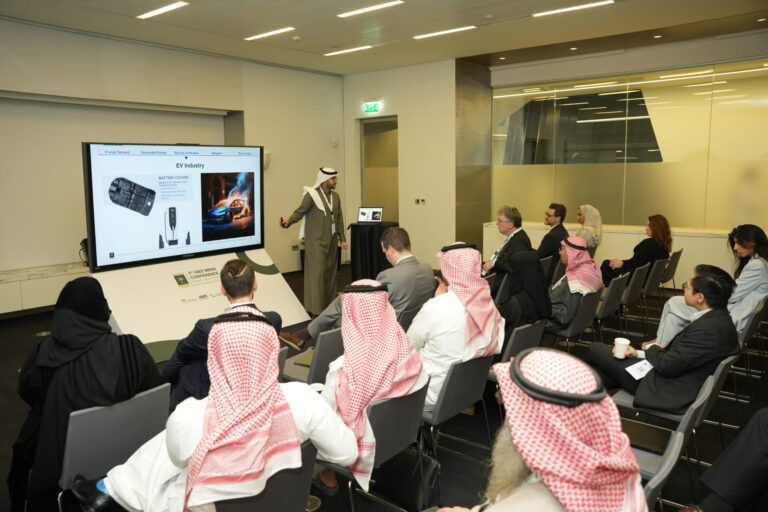The government sector significantly influences Saudi Arabia’s energy demand, playing a crucial role in the country’s efforts to achieve a sustainable energy transition, diversify its energy mix, and reduce reliance on fossil fuels—outlined in Saudi’s Vision 20301. Previously, KAPSARC has looked into the Kingdom’s total electricity consumption for residential, commercial, and industrial sectors,2,3,4 However, a key gap has been the analysis of regional data for the government sector.
To address the lack of information, KAPSARC research fellow Jeyhun I. Mikayilov and researcher Information Management Lead Abeer Al Ghamdi produced ‘Impacts of Regional Electricity Demand in Saudi Arabia. A Study of the Government Sector.’ The study5 aims to investigate the factors influencing electricity demand across the central, eastern, southern, and western regions, taking into consideration income, climate, and regional development characteristics.

“Recognizing regional variations in government electricity consumption offers crucial insights into the effectiveness of energy policies and helps craft targeted strategies to enhance energy efficiency, conservation, and sustainable practices across the country,” say Mikayilov and Al Ghamdi.
The study looks at how government electricity use is influenced by income, electricity prices, and weather conditions. It includes data from the Saudi Arabia Electricity Corporation (SEC) from 1990-2004, and from the Saudi Arabian Monetary Authority (SAMA) from 2005-2021.
“Recognizing regional variations in government electricity consumption offers crucial insights into the effectiveness of energy policies and helps craft targeted strategies to enhance energy efficiency, conservation, and sustainable practices across the country.”
Between 2017 and 2022, the government sector in Saudi Arabia accounted for 13% of the Kingdom’s total electricity consumption. A significant portion (83%) of this electricity use is allocated to air-conditioning, ventilation, heating, lighting, and refrigeration systems.6 The country’s central region, which hosts numerous government institutions, stands out as the highest electricity consumer in this sector.
Mapping the Kingdom’s electricity use
Income was shown to play a significant role in the government sector’s electricity demand. Generally, higher income corresponds to higher electricity consumption. However, changes in income have a smaller impact on electricity demand in the more established eastern and central regions of the country. This suggests that as areas grow economically, the increase in energy use eventually reaches a saturation point and levels off.

Using estimated customer and region-specific electricity demand models, the study also calculated how sensitive each region is to changes in income and electricity prices. Overall, the southern region is the most responsive to changes in income, while the western region demonstrates the highest responsiveness to price changes across regions. These results align with the development levels of the regions, and support previous findings published in 2023 by KAPSARC’s Mikayilov and his colleague Abdulelah Darandary.3
Toward energy efficiency
Hot weather conditions increase government electricity consumption, especially in the central region as higher temperatures lead to greater electricity usage, likely due to air conditioners in public facilities. Riyadh alone accounted for about 36% in 2021, making the capital the highest electricity consumer in the government sector.
“To support efficient energy use, the Saudi government established the National Energy Service Company, which aims to retrofit 110,000 government buildings and 35,000 public schools for energy efficiency. This activity is now in progress and it would be interesting to repeat our study after the completion of this big effort,” the authors explain.
Finally, education and awareness programs that encourage government employees to be more mindful of their energy consumption behaviors are recommended to help foster a culture of energy responsibility within the government sector.
Reference
1. Saudi Vision. 2030 | Article
2. Gasim, A. A., Agnolucci, P., Ekins, P. and De Lipsis, V., Modeling final energy demand and the impacts of energy price reform in Saudi Arabia. Energy Economics, 120, 106589, 2023. | Article
3. Mikayilov, J.I. and Darandary, A., Modeling and projecting regional electricity demand for Saudi Arabia. 2023.| Article
4. Hasanov, F.J., Joutz, F.L., Mikayilov, J.I. and Javid, M., KGEMM: A macroeconometric model for Saudi Arabia. 2022. | Article
5. Mikayilov, J.I. and Al Ghamdi, A., Impacts of regional electricity demand in Saudi Arabia: A Study of the government sector. 2024. | Article
6. Damoom, M. M., Hashim, S., Aljohani, M. S. and Saleh, M. A. Adding sustainable sources to the Saudi Arabian electricity sector. The Electricity Journal 31 (4), 20–28, 2018. | Article




